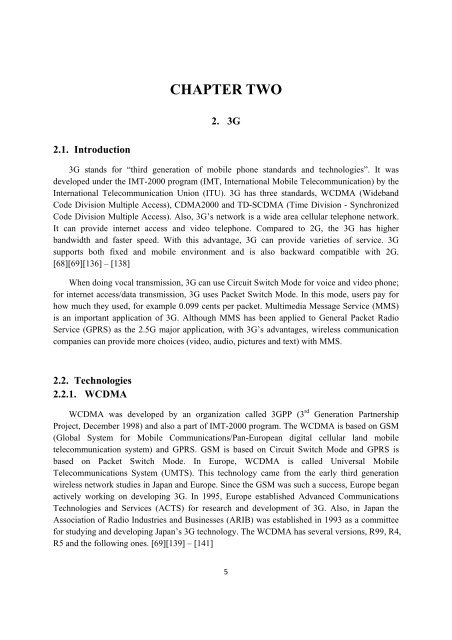A comparison of wi-fi and wimax with case studies - Florida State ...
A comparison of wi-fi and wimax with case studies - Florida State ...
A comparison of wi-fi and wimax with case studies - Florida State ...
Create successful ePaper yourself
Turn your PDF publications into a flip-book with our unique Google optimized e-Paper software.
2.1. Introduction<br />
CHAPTER TWO<br />
2. 3G<br />
3G st<strong>and</strong>s for “third generation <strong>of</strong> mobile phone st<strong>and</strong>ards <strong>and</strong> technologies”. It was<br />
developed under the IMT-2000 program (IMT, International Mobile Telecommunication) by the<br />
International Telecommunication Union (ITU). 3G has three st<strong>and</strong>ards, WCDMA (Wideb<strong>and</strong><br />
Code Division Multiple Access), CDMA2000 <strong>and</strong> TD-SCDMA (Time Division - Synchronized<br />
Code Division Multiple Access). Also, 3G’s network is a <strong>wi</strong>de area cellular telephone network.<br />
It can provide internet access <strong>and</strong> video telephone. Compared to 2G, the 3G has higher<br />
b<strong>and</strong><strong>wi</strong>dth <strong>and</strong> faster speed. With this advantage, 3G can provide varieties <strong>of</strong> service. 3G<br />
supports both <strong>fi</strong>xed <strong>and</strong> mobile environment <strong>and</strong> is also backward compatible <strong>wi</strong>th 2G.<br />
[68][69][136] – [138]<br />
When doing vocal transmission, 3G can use Circuit S<strong>wi</strong>tch Mode for voice <strong>and</strong> video phone;<br />
for internet access/data transmission, 3G uses Packet S<strong>wi</strong>tch Mode. In this mode, users pay for<br />
how much they used, for example 0.099 cents per packet. Multimedia Message Service (MMS)<br />
is an important application <strong>of</strong> 3G. Although MMS has been applied to General Packet Radio<br />
Service (GPRS) as the 2.5G major application, <strong>wi</strong>th 3G’s advantages, <strong>wi</strong>reless communication<br />
companies can provide more choices (video, audio, pictures <strong>and</strong> text) <strong>wi</strong>th MMS.<br />
2.2. Technologies<br />
2.2.1. WCDMA<br />
WCDMA was developed by an organization called 3GPP (3 rd Generation Partnership<br />
Project, December 1998) <strong>and</strong> also a part <strong>of</strong> IMT-2000 program. The WCDMA is based on GSM<br />
(Global System for Mobile Communications/Pan-European digital cellular l<strong>and</strong> mobile<br />
telecommunication system) <strong>and</strong> GPRS. GSM is based on Circuit S<strong>wi</strong>tch Mode <strong>and</strong> GPRS is<br />
based on Packet S<strong>wi</strong>tch Mode. In Europe, WCDMA is called Universal Mobile<br />
Telecommunications System (UMTS). This technology came from the early third generation<br />
<strong>wi</strong>reless network <strong>studies</strong> in Japan <strong>and</strong> Europe. Since the GSM was such a success, Europe began<br />
actively working on developing 3G. In 1995, Europe established Advanced Communications<br />
Technologies <strong>and</strong> Services (ACTS) for research <strong>and</strong> development <strong>of</strong> 3G. Also, in Japan the<br />
Association <strong>of</strong> Radio Industries <strong>and</strong> Businesses (ARIB) was established in 1993 as a committee<br />
for studying <strong>and</strong> developing Japan’s 3G technology. The WCDMA has several versions, R99, R4,<br />
R5 <strong>and</strong> the follo<strong>wi</strong>ng ones. [69][139] – [141]<br />
5
















